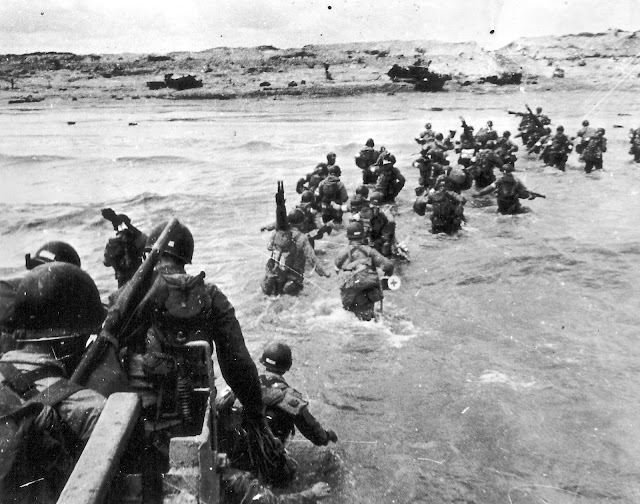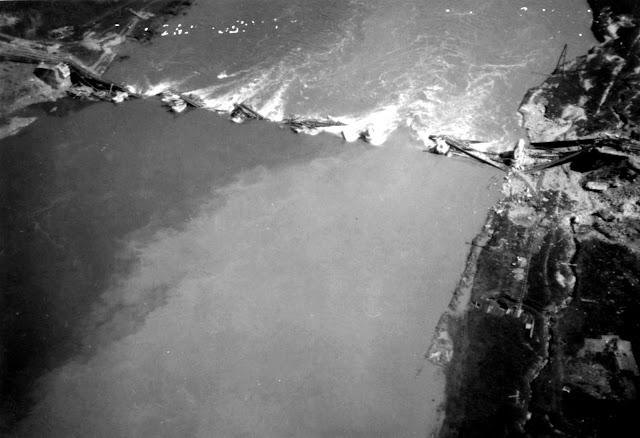PFC. CUTHBERT POWELL (KIP) SINKKING, WWII: Class of '42 gave 3 of its own to the ages
 |
| As 4th Infantry Division troops (pictured) pressed their way through German defenses into the Rhineland in western Germany in late January and early February 1945, they learned to take advantage of abandoned and captured German pillboxes like this one for refuge from German artillery and snipers to take a break, ever-so-briefly, from the rigors of combat. Pfc. Cuthbert P. (Kip) Sinkking of Irvington was a member of the 4th Division's 12th Infantry Regiment, killed in action in the Rhineland on Feb. 9, 1945. (Photo courtesy City University of New York Department of History, 4th Infantry Division Yearbook) |
Private first class Cuthbert Powell (Kip) Sinkking was the youngest of three brothers, raised in a one-parent household in the gardener’s cottage of a Gilded Age Broadway estate in Irvington.
And he was the second of three Irvington High School Class of 1942 student-athletes to die in the winter of 1945 fighting the desperate German army.
Winterly’s one-time entrance of curving granite walls is blocked off by a granite wall parallel to Broadway today. The granite building near that sealed entrance today could be the former Kipp house on the estate, but that’s not clear.
Ulysses Kipp was May’s gardener in 1925 and by 1930 had been promoted to superintendent.
The Sinkking boys’ father does not appear to have been living with the family from 1918 on, although he was indicated by surname as the father of two sons with Belle born after that date: William and Cuthbert.
J.H. Sr. had issues. According to a newspaper report of the era, he volunteered for the U.S Navy at about age 15 in 1912 and served four years before resigning and enlisting in the U.S. Army in 1916. He was assigned to what the paper called the Military Detachment Engineers Corps, which may have actually been the U.S. Army Corps of Engineers and assigned to duty at the U.S. Military Academy at West Point, N.Y., as a private first-class.
Also in 1916, he married Belle, daughter of Ulysses and Mary E. Kipp of Rhinebeck, N.Y., with the wedding held at a Rhinebeck estate known as “The Hook,” where Ulysses worked as a gardener.
James Sr. was discharged from the Army on Feb. 15, 1919 while serving a civilian court prison sentence at the Connecticut Reformatory in Cheshire, Conn., which at that time was reserved for inmates 24 and younger. He had been imprisoned for an unspecified civilian offense no later than August 1918.
By 1925, the Ohio-born James Sr. was out of prison and living in his Cincinnati boyhood home with his mother and father, Harry J. and Aline Sinkking. He would go on to move with his mother to Evansville, Indiana, where he remained until his death at age 74 in 1972.
Belle divorced James Sr. in 1932, after apparently having been unable to locate him to serve the divorce papers. A Nov. 30, 1931 newspaper ad announced that it was serving as official notice to James Sr. of his pending divorce.
 |
| Fourth Infantry Division troops cross the Sauer River from Luxembourg into western Germany on Jan. 18, 1945. (Photo courtesy City University of New York Department of History, 4th Infantry Division Yearbook) |
We know that young Kip was an athlete — he was on the same Irvington High School baseball team as Arnold J. Meszaros, his Class of 1942 classmate who was killed in action in the same general area as Kip just three weeks later. Kip was also a regular actor, appearing on stage particularly in productions involving Hope Presbyterian Church in the Pennybridge section of Tarrytown, his family’s congregation.
After high school graduation in spring 1942, Kip appears to have been employed by Lord & Burnham Co. on Astor Street as a woodworker who also handled general assignments. By the time Kip was inducted by the Army on April 25, 1944, his older brothers were already in the armed forces.
Oldest brother James H. Jr., or “Harry,” who enlisted on March 4, 1941, was part of the initial D-Day invasion at Utah Beach in Normandy on June 6, 1944 and would go on to serve at headquarters of the 4th Infantry Division through northern France, Belgium, Luxembourg and into the German Reich itself in late 1944 and early 1945.
Middle brother John W., or “William,” became a decorated pilot with the U.S. Army Air Forces who flew B-29 Flying Fortresses with the 401st Bombardment Group flying from 8th Army Air Forces Bomber Station based at High Wycombe, England, some 30 miles west of London.
After his April 1944 induction, Kip, a private, was assigned to Camp Croft, S.C., until mid-October 1944, then to Fort Meade, Md., in late October 1944. It’s not clear when he was deployed with Company C of the 12th Infantry Regiment to the 4th Infantry Division, but it likely came in late November or early December of 1944. The 12th was decimated while fighting the Battle of Hürtgen Forest in the first 10 days of November and had to be heavily reinforced. Kip and his fellow youngsters from the U.S. were the likely replacements, by that time called reinforcements by order of Army brass.
Kip would go on to join the recuperating 4th Division in what was considered the quiet sector of Belgium, the Ardennes Forest, that quickly caught fire as the Germans shocked Allied leadership by launching an offensive on Dec. 16 that became the life-and-death Battle of the Bulge, the bloodiest single battle of World War II fought by the U.S.
 |
| This photo taken in February 1945 shows 4th Infantry Division troops advancing along dirt roads in the Rhineland, western Germany, around the time of the battlefield death of 12th Infantry Regiment, 4th Division soldier Kip Powell. (Photo courtesy City University of New York Department of History, 4th Infantry Division Yearbook) |
Pfc. Sinkking, who had been recommended for promotion by this time, was in the vanguard of the advancing U.S. forces, killed in action in the Rhineland east of the Luxembourg frontier, nine days later, Feb. 9, 1945. The hospital where he was taken from the battlefield reported he died of head and other wounds caused by shrapnel from an artillery shell.
Kip was engaged to be married to Theresa A. Kral of North Tarrytown (today’s Sleepy Hollow) at the time of his death. His mother Belle at that point was living at 106 Main St., one house west of Croton Place. She would go on to live with son Harry Jr. on the Frank Jay Gould estate in Ardsley Park. The Gould mansion now serves at the clubhouse of Ardsley Country Club. Harry worked for Gould.
Kip's brother, Corporal “Harry” Sinkking Jr., was serving at 4th Infantry Division headquarters when Kip was killed. Tragically, Harry had just written home to his mother about Kip doing well, when in fact, Kip had already died. Headquarters had not yet been notified of his death.
Pfc. C.P. Sinkking was temporarily interred in the Luxembourg American Cemetery outside Luxembourg City, which would also be the temporary burial place of his former Irvington High baseball teammate Sgt. Arnold J. Meszaros about a month later.
Back home, Pfc. Sinkking was honored with a tree planted in his memory at Hope Presbyterian Church, 500 S. Broadway, Tarrytown on Sept. 15, 1946. The church is the First Korean Methodist Church today. Trees were also planted at the church that day in honor of William T. Hyler and Goran K. Asp, other congregants who died in the war.
Pfc. Sinkking’s remains were returned to the U.S. on March 10 1949. He lay in repose at Vanderbilt Funeral Home, Tarrytown on April 1. Irvington Post 2911 of the Veterans of Foreign Wars oversaw his funeral at Hope Presbyterian and burial at Old Stone Church Lutheran Cemetery in Rhinebeck, N.Y. with full military honors on Saturday, April 2.
AUTHOR’S NOTES: Kip's older brothers both survived the war and went on to marry and have families of their own. Belle moved to Tarrytown, North Tarrytown (today's Sleepy Hollow) and finally California, where she died while living with middle son William and his family. … Lt. Robert Chalot, the first of the three IHS Class of ‘42 members to be killed in action, died when his the bomber he was piloting crashed and exploded shortly after taking off from a French runway at the start of an ill-fated bombing run over Germany on New Year’s Day 1945. ... Sgt. Arnold Meszaros, the third member of the Class of '42, was killed in action on March 3, 1945 south of Weinsheim, Germany, some 47 miles east of the Luxembourg-Germany frontier. ...
Links to similar personal stories about Irvington heroes who gave their lives for their country*
◼ Pfc. Cuthbert Powell (Kip) Sinkking: Class of '42 gave 3 of its own to the ages
◼ Pfc. John Joseph (Joe) Gilchrist: Died after capture of Saint-Lo
◼ Lt. (j.g.) George Eddison Haines: Lost at sea, awarded Silver Star
◼ Pfc. Joseph Thomas Costello: Teen lost life in Battle of Mindanao
◼ MSgt. James Peter Kelley: Survived WW II and Korea; died in fall
◼ S1 Archibald Ronald: Lost on next-to-last Navy ship sunk by U-boat
◼ TSgt. Raffaele R. (Ralph) Reale: A hero's life ended on East Sunnyside Lane
◼ Sgt. Robert F. Morrison: Took fight to the enemy, fell in Alsace
◼ Lt. Col. George W. Beavers Jr.: Re-upped as private; died on war's eve
◼ F2 Claude L. Bronnes: Went down with the Atlanta at Guadalcanal
◼ MMLC William James Downey: Died aboard ship off West Coast
◼ Pvt. Alick Main Ian: Died taking Aachen, first German city to fall in WWII
◼ Pfc. George Mills Hill Jr.: Survived Okinawa, only to fall in South Korea
◼ Pvt. Peter R. Robinson: Lost to shadows of time over Pacific, answers never found
WORLD WAR I










Comments
Post a Comment